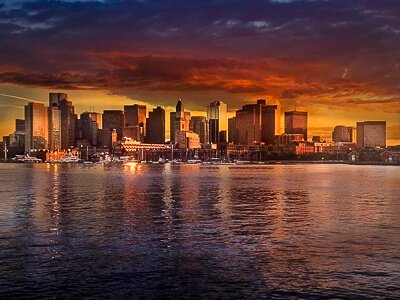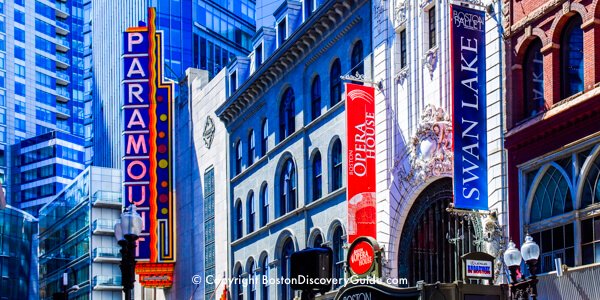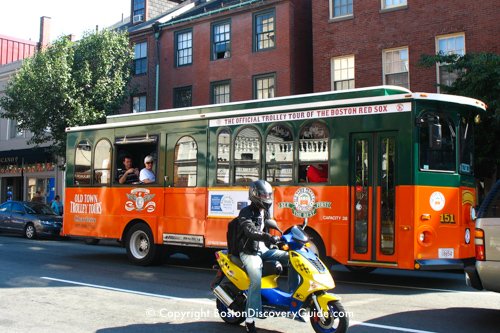Boston's Old State House boasts a colorful history, but most people remember it today because the Boston Massacre - a deadly confrontation between Colonists and British soldiers considered to be the first bloodshed of the American Revolution - took place under its East Balcony on a snowy March day in 1770.
Today, the Old State House serves as a museum dedicated to Revolutionary Boston and the events leading up to the beginning of the War for Independence.
Each March, costumed reenactors bring the Boston Massacre to life to commemorate the event, complete with participation from the crowd. (See our March Events Calendar for details.)
Other reenactments of Boston's Colonial period take place thro
ughout the year, and you can often see the costumed reenactors on the outdoor plaza next to the Old State House.
In addition to being the city's oldest surviving public building and a museum dedicated to Revolutionary Boston, this Freedom Trail site also has the distinction of being the oldest historic building in the United States to house a subway station in its sub-basement.
Top Photo: Old State House, with Custom House Tower and other Financial District buildings in the background
Boston Discovery Guide is a reader-supported publication. When you buy through our links, we may earn a commission at no additional cost for you. Learn more
What Happened in American History at the Old State House
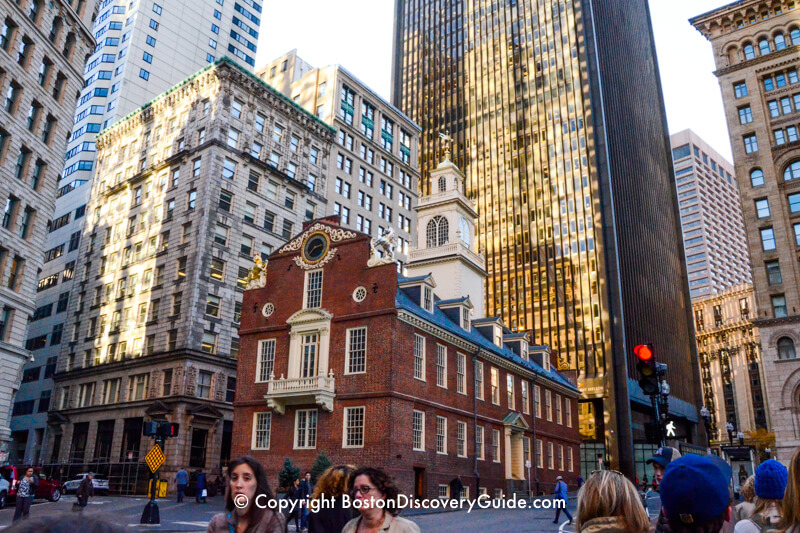
Three important American Revolution events took place at the Old State House, cementing its status as a Freedom Trail site:
The first event occurred in 1761 when lawyer James Otis, Jr. spoke for 8 solid hours in opposition to the newly imposed Writs of Assistance, which gave British authorities the right to enter and search private homes and ships for smuggled goods.
John Adams called Otis's speech "the first scene of the first act of opposition to the arbitrary claims of Great Britain. Then and there the child Independence was born."
The second critical event occurred outside the Old State House under the East Balcony (shown in photo above) on March 5, 1770, when British soldiers fired into a rowdy crowd of Colonials and killed 5 men. The Boston Massacre, as this terrible event came to be called, is considered the first bloodshed of the American Revolution.
Finally, on July 18, 1776, the Declaration of Independence was read for the first time in Boston from the East Balcony to a large crowd outside. Afterward, carved figures of a royal lion and unicorn, symbols of English rule, were ripped from the roof and burned in a huge bonfire.
By 1776, building had officially become the Massachusetts State House . . . until 1798 when the government moved to the current State House.
Exhibits & Events in the Old State House Museum
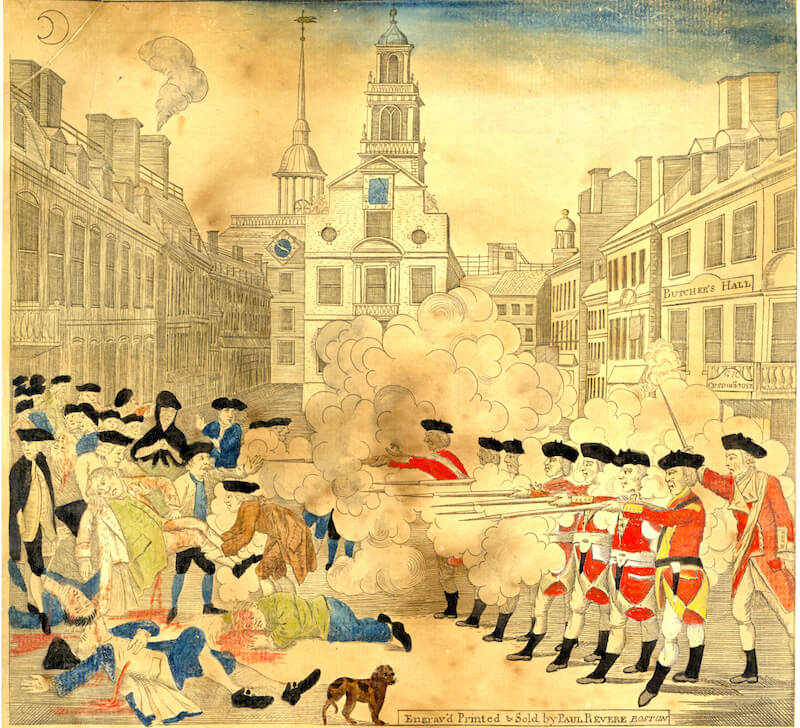
The Old State House Museum has wonderful exhibits designed to make the events that shaped the making of the colony, state, and country come alive.
You'll find two floors of interactive, hands-on exhibitions about the role that the building played in the events leading up to the American Revolution - the Boston Tea Party, the Boston Massacre, and other events.
You can also see Paul Revere's famous engraving depicting the Boston Massacre. Although it appears in lots of elementary school history textbooks to illustrate the event, the museum points out that Revere deliberately misrepresented the actual event in order to use the picture as propaganda to incite anti-British feelings.
In other exhibits, you'll see real tea from the Boston Tea Party (recovered from a participant's boots!), John Hancock's coat, and other relics from the Revolutionary War period.
In addition to the Boston Massacre Reenactment each March, you can hear the annual reading of the Declaration of Independence here on each July 4th.
Tours are offered daily at 3pm (free with Old State House admission). From June - October, costumed reenactors representing Revolutionary characters are present to talk with you about what it was like to live in Boston during the exciting days leading up to the beginning of the American Revolution, and to answer your questions.
The museum also hosts special evening lectures periodically - check their website (below) to find scheduled events.
Directions & Other Information for Old State House Visitors
- Location: 206 Washington Street, on the Freedom Trail; the Museum is not wheelchair accessible because its status as a National Landmark makes adding an elevator problematic at this time.
- Cost and Hours: The Old State House is open from 9am - 5pm on most days of the year - See Old State House website (www.bostonhistory.org) for current information
- Discounts for Old State House: GoBoston card gives you free admission
- More information: 617-720-1713
- Getting there by subway: Orange and Blue Lines/State Street (directly beneath the Old State House - couldn't be closer!); alternately, take Red Line/Downtown Crossing or Green Line/Government Center
- Park: Boston Common Garage is easy - just follow the Freedom Trail from the Common to the Old State House
More about the Old State House: History
Boston's Old State House was originally built as a multipurpose building - a tradition it continues to the present day in its role as a museum, a Freedom Trail site, and at the basement level, a subway station.
The Old State House actually sits on the site of an earlier 1658 building called the Town House. After the Great Fire of 1711 destroyed it, a new structure known as the New Town House arose from the ashes in 1713.
For much of the 18th century until the American Revolution began, the second floor of the Old State House contained offices for the British Royal Governors - and for the Massachusetts Assembly.
As you might imagine, this shared space became an explosive combination as tensions grew between England and the Colonials.
After the end of the War for Independence, Paul Revere worked in it during 1799-1800.
Freedom Trail Tours
Directions & Other Information for Old State House Visitors
- Location: 206 Washington Street, on the Freedom Trail; the Museum is not wheelchair accessible because its status as a National Landmark makes adding an elevator problematic at this time.
- Cost and Hours: The Old State House is open from 9am - 5pm on most days of the year - See Old State House website (www.bostonhistory.org) for current information
- More information: 617-720-1713
- Getting there by subway: Orange and Blue Lines/State Street (directly beneath the Old State House - couldn't be closer!); alternately, take Red Line/Downtown Crossing or Green Line/Government Center
- Park: Boston Common Garage is easy - just follow the Freedom Trail from the Common to the Old State House
Where to Stay near the Old State House & the Freedom Trail
The historic Omni Parker House Hotel (shown in photo) is close to Old State House as well as other Freedom Trail sites near Boston Common:
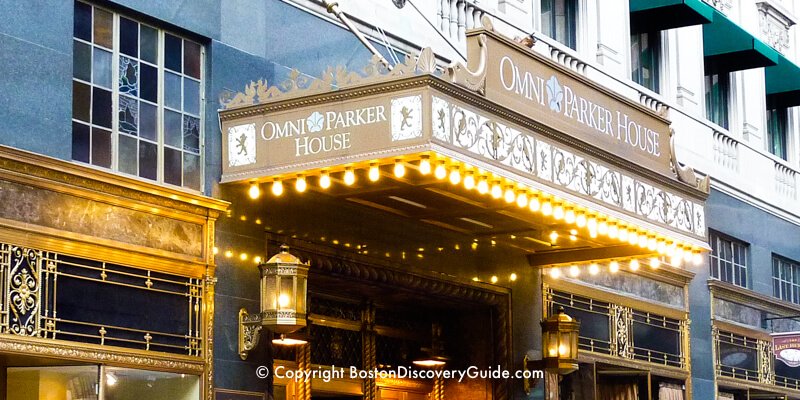
More top hotels near the Old State House & the Freedom Trail in Boston's Historic Downtown:
Check out more hotels in Historic Downtown Boston
More Fun Ways to See Boston near the Freedom Trail
Boston Freedom Trail Sites
Boston Common | Massachusetts State House | Park Street Church | Granary Burying Ground | King's Chapel | King's Chapel Burying Ground | Benjamin Franklin Statue | Old Corner Bookstore | Old South Meeting House | Old State House | Boston Massacre Memorial | Faneuil Hall | Old North Church | Paul Revere's House | Copp's Hill Burying Ground | Bunker Hill Monument | USS Constitution
More Articles about Boston's Freedom Trail
- Boston's Freedom Trail - Find more sites to visit on Boston's famous Walk through History
- Boston Massacre - Find out what really happened
- Historic Downtown Boston - Find more places to visit in this interesting part of the city
- Faneuil Marketplace - Shop and dine in this Freedom Trail site
- More Top Boston Attractions - Find more interesting things to see and do in Boston


